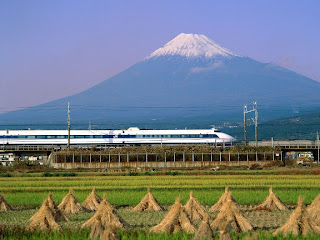 |
| Mt Fuji in the distance behind a shinkansen |
It is 3776 metres high (that is almost 4 km!!) and considered one of the most beautiful places in Japan to visit. It is nearly 50 km around the base, and the summit crater is about 250 m deep, with a diameter of about 500 meters. It is so large, it can be seen by the space station - this photo was taken by one of the astronauts at the space station.
 |
| A photo taken of Mt Fuji from a space station |
Mt Fuji's history is long and fascinating. It is the largest volcano in Japan and there are records which stretch back more than 100,000 years. Scientists have found a number of ancient volcanoes under what is currently known as Mt Fuji - some of these date back more than 700,000 years. However, the current volcano, referred to as 'New Mt Fuji' came into being about 10,000 years ago.
| Beneath the current volcano lie many ancient volcanoes |
There have been 16 recorded eruptions of Mt Fuji since 781. Mt Fuji erupted 12 times in the period between 800 and 1083, then was silent for more than 400 years. The most recent eruption was in 1707/8, and it was known as the Great Hoei Eruption. This eruption caused a crater which can be seen today, just to the right of the peak of MtFuji.
 |
| The Hoei crater can be seen to the right of the peak |
Climbing Mt Fuji
 |
| Stations on the climbing trail of Mt Fuji |
If you want to climb Mt Fuji, you can do so in July and August, which is the official climbing season. At all other times of the year, the temperature at the summit can drop below zero and is covered in snow so can be dangerous. There are a couple of different trails that you can take to climb the mountain, but it is recommended that you rest on the way in one of the many huts that line the trails.
Many people take two days to climb Mt Fuji and time their climb to arrive at the summit in time to watch sunrise.
Approximately 300,000 people climb Mt Fuji during climbing season each year.
 |
| The hut at the 8th station |
 |
| The climbing trail on Mt Fuji |
 |
| The hut at the summit of Mt Fuji |
 |
| A warning poster for climbers attempting to climb outside of climbing season |
 |
| Mt Fuji, surrounded by five lakes |
Mt Fuji is as old as Japan itself and has been the inspiration for art and poetry for centuries. Hokusai was one of the greatest artists in Japan, and created many Ukiyo-e prints of Mt Fuji which have become famous. Here are some of the most famous Ukiyo-e prints:
http://en.fujisan223.jp/
http://www.fujisan-net.gr.jp/english/3_01.htm




